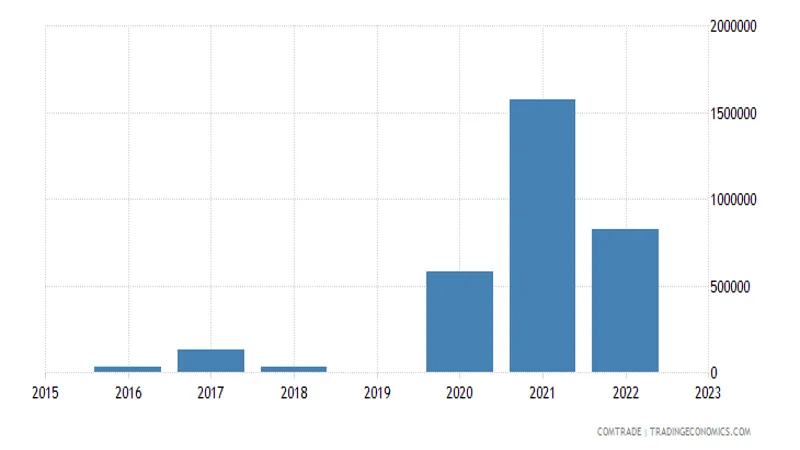In 2024, Tajikistan’s trade landscape witnessed significant shifts, revealing both challenges and opportunities within its export and import dynamics. With total exports declining by 20.5% to $1.947 billion, the nation faced a notable trade deficit despite robust engagement with global markets. China and Switzerland emerged as key players in Tajikistan’s export strategy, while imports surged, predominantly from Russia and China. This evolving economic scenario not only highlights the complexities of Tajikistan’s trade relationships but also sets the stage for a deeper exploration of its foreign trade performance and strategic partnerships in a global context.
| Category | 2024 | Comparison with Previous Year |
|---|---|---|
| Total Exports | $1.947 billion | 20.5% decline from 2023 (total exports were $2.447 billion in 2023) |
| Top Export Destinations | China (21.1%) | – |
| Switzerland (19.4%) | – | |
| Turkey (12.3%) | – | |
| Kazakhstan (10.1%) | – | |
| Uzbekistan (9.1%) | – | |
| Total Imports | $7.008 billion | 19.2% increase from 2023 |
| Top Import Suppliers | Russia (26.9%) | – |
| China (22.1%) | – | |
| Kazakhstan (15.6%) | – | |
| Trade Surplus | Switzerland: $29.4 million | – |
| Afghanistan: $91.1 million | – | |
| Countries Engaged in Trade | 121 nations | Including 10 CIS countries and 111 non-CIS states |
| 1H24 Exports | $997 million | 47% increase from 1H23 (total exports were $678 million in 1H23) |
| Major Export Destinations in 1H24 | Switzerland: $298.5 million | – |
| China: $186.8 million | – | |
| Kazakhstan: $118.7 million | – | |
| Turkey: $111.1 million | – | |
| Uzbekistan: $80.4 million | – |
Tajikistan’s Export Overview in 2024
In 2024, Tajikistan’s exports of goods were valued at approximately $1.947 billion. This amount shows a significant decline of 20.5% from the previous year. Such a drop might raise concerns about the country’s economic stability and its ability to compete in the global market. Understanding these figures is essential as they reflect the country’s trade health and its role in international commerce.
Despite the decline in total exports, Tajikistan’s trade dynamics are intriguing. The country has a variety of export partners, with China and Switzerland being the most prominent. This indicates that Tajikistan has strategic trade relationships that can influence its economic prospects. Keeping track of these relationships helps us comprehend the bigger picture of Tajikistan’s economy and its trade strategies.
Frequently Asked Questions
What was the total value of Tajikistan’s exports in 2024?
In 2024, Tajikistan’s exports totaled $1.947 billion, showing a decline of 20.5% compared to the previous year.
Which countries are the top export destinations for Tajikistan?
The top export destinations for Tajikistan are China (21.1%) and Switzerland (19.4%), followed by Turkey, Kazakhstan, and Uzbekistan.
How much did Tajikistan’s imports increase in 2024?
Tajikistan’s imports surged by 19.2% in 2024, reaching $7.008 billion.
Who were the largest suppliers of imports to Tajikistan?
The largest suppliers of imports to Tajikistan were Russia (26.9%), China (22.1%), and Kazakhstan (15.6%).
Did Tajikistan have a trade surplus or deficit in 2024?
Tajikistan experienced an overall trade deficit in 2024, but had surpluses in trade with Switzerland and Afghanistan.
How many countries did Tajikistan engage in foreign trade with in 2024?
In 2024, Tajikistan engaged in foreign trade with 121 countries, including ten CIS countries and 111 non-CIS states.
What was the value of Tajikistan’s exports in the first half of 2024?
In the first half of 2024, Tajikistan’s exports rose to $997 million, a 47% increase from the same period in 2023.
Summary
In 2024, Tajikistan’s exports dropped to $1.947 billion, a 20.5% decrease from the previous year. China and Switzerland were the top buyers, making up over 40% of the total exports. Meanwhile, imports rose by 19.2%, reaching $7.008 billion, with Russia leading as the main supplier. Tajikistan had a trade deficit overall but enjoyed surpluses with Switzerland and Afghanistan. In the first half of 2024, exports increased by 47% to $997 million, showcasing strong trade relations with various countries, including significant growth in sales to Switzerland and China.



